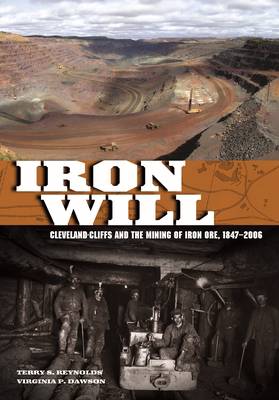
- Retrait gratuit dans votre magasin Club
- 7.000.000 titres dans notre catalogue
- Payer en toute sécurité
- Toujours un magasin près de chez vous
- Retrait gratuit dans votre magasin Club
- 7.000.0000 titres dans notre catalogue
- Payer en toute sécurité
- Toujours un magasin près de chez vous
Iron Will
Cleveland-Cliffs and the Mining of Iron Ore, 1847-2006
Terry S Reynolds, Virginia P DawsonDescription
The history of Cleveland-Cliffs, a company that played a key role in iron mining development in the Lake Superior region.
In Iron Will: Cleveland-Cliffs and the Mining of Iron Ore, 1847--2006, Terry S. Reynolds and Virginia P. Dawson tell the story of Cleveland-Cliffs, the only surviving independent American iron mining company, now known as Cliffs Natural Resources. Headquartered in Cleveland, Ohio, Cleveland-Cliffs played a major role in the opening and development of the Lake Superior mining district and Michigan's Upper Peninsula. Through Cleveland-Cliffs' history, Reynolds and Dawson examine major transitions in the history of the American iron and steel industry from the perspective of an important raw materials supplier.
Reynolds and Dawson trace Cleveland-Cliffs' beginnings around 1850, its growth under Samuel L. Mather and his son William G. Mather, its emergence as an important player in the growing national iron ore market, and its tribulations during the Great Depression. The authors explore the company's fortunes after World War II, when Cleveland-Cliffs developed technologies to tap into vast reserves of low-grade Michigan iron ore and turned to joint ventures and strategic partnerships to raise the capital needed to implement them. The authors also explain how the company became the largest independent producer of iron ore in the United States by purchasing the mining interests of its bankrupt partners during the implosion of the American steel industry in the late-twentieth and early twenty-first centuries. Reynolds and Dawson detail Cleveland-Cliffs' evolving efforts to deal with labor, from its early mostly immigrant workforce to its ambitious program of welfare capitalism in the early twentieth century to its struggles with organized labor after World War II.
Iron Will is a thorough, well-organized history based on extensive archival research and interviews with company personnel. This story will appeal to scholars interested in industrial or mining history, business historians, and those interested in Great Lakes and Michigan history.
Spécifications
Parties prenantes
- Auteur(s) :
- Editeur:
Contenu
- Nombre de pages :
- 360
- Langue:
- Anglais
- Collection :
Caractéristiques
- EAN:
- 9780814335116
- Date de parution :
- 15-04-11
- Format:
- Livre relié
- Format numérique:
- Genaaid
- Dimensions :
- 189 mm x 261 mm
- Poids :
- 943 g

Les avis
Nous publions uniquement les avis qui respectent les conditions requises. Consultez nos conditions pour les avis.






